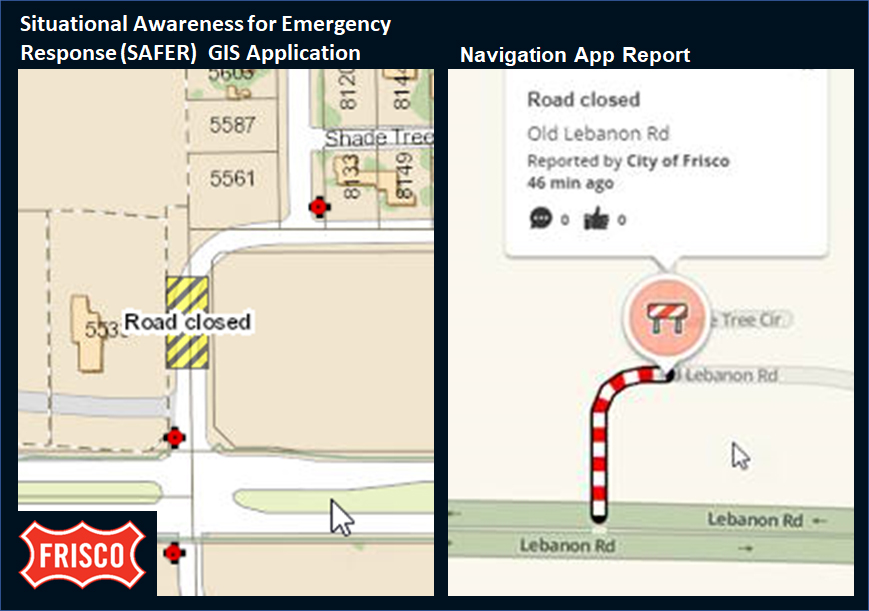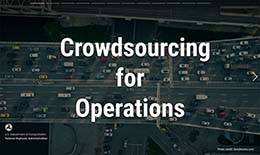January 14, 2021
Innovation of the Month:
Crowdsourcing for Advancing Operations
Last week, we introduced you to crowdsourcing for advancing operations, an innovation that addresses transportation system management and operations (TSMO) needs by enlisting the services of a large number of people through technology. This week, we’ll tell you how the City of Frisco, Texas, used crowdsourcing to help public safety dispatchers provide accurate information to the responder community on a wide range of traffic incidents.
For minor situations such as debris on the road, travelers may only notify their navigation app and skip a 911 call, leaving the hazard on the road far too long. For major incidents, 911 dispatchers will likely receive multiple phone calls but sometimes receive imprecise or conflicting location information from these calls. This can delay responders' arrival on the incident scene and increase the likelihood of a secondary crash. To address these challenges, the City of Frisco integrated real-time crowdsourced data from a free navigation app into their Situational Awareness for Emergency Response (SAFER) platform. SAFER is a unique platform that makes a breadth of emergency response information available through a geographic information system (GIS) interface to firefighters, emergency medical technicians (EMT), law enforcement, and other responder communities.

SAFER filters the crowdsourced data and maps relevant events (major crashes, minor crashes, and roadway debris) to provide public safety dispatchers more timely and complete information. Preliminary analysis reveals that for about 10 percent of calls, the incidents reported through the navigation app are detected five to seven minutes earlier on SAFER than a 911 phone call. Frisco's public safety dispatch officers also use the SAFER platform to define emergency road closures, which automatically transmit to the navigation app provider. These closures appear on the app interface and help travelers navigate around emergency road closures. Crowdsourcing helped Frisco public safety officers detect incidents more quickly and accurately, which in turn helps keep travelers and emergency responders safe.
To learn more about crowdsourcing for advancing operations, contact James Colyar, Greg Jones, or Ralph Volpe, EDC-6 team co-leads or visit the team’s EDC website.
EDC Storyboard – Improving Safety and Operations with Crowdsourcing for Advancing Operations

EDC storyboards are a new way to communicate innovation deployment stories in an interactive digital slideshow–incorporating photographs, video, and graphics to create a highly visual experience.
Our latest storyboard shows how crowdsourcing technology has improved safety and operations for agencies including the Indiana Department of Transportation, the City of Louisville, the Utah Department of Transportation, and Lake County, IL.
Check it out and let us know what you think about the storyboard!
For more information on implementing this lower-cost, proven technology, contact James Colyar with the Crowdsourcing for Advancing Operations team.
Delaware Optimizes Snowplow Routes for Improved Service
During Winter 2019, the Delaware Department of Transportation (DelDOT) optimized snowplow routes in their South District for mileage efficiency in two of its five Area yards. The optimized routing enables snowplows to leave a yard and return at no more than 10 percent capacity on a standard route with a 1.5-hour cycle time. For periods of greater snowfall intensity, shorter routes are created by removing the lowest priority roads. For example, during a blizzard event, 30-minute cycle times are used.
DelDOT noted that the optimized routes have improved the Department's level of service. It has allowed more roads to be plowed earlier, reduced the snow removal service times, and shortened the amount of travel over roads not being serviced. The agency is currently working to optimize the remaining three Area yards and DelDOT is also assessing the use of an in-vehicle GPS routing application for continuing to optimize its snowplow routes.
To learn more about how DelDOT conducted this optimization, please contact Jason McCluskey with DelDOT. To learn how your agency can become more efficient with winter operations or other weather-responsive management strategies, contact David Johnson with the FHWA Office of Operations.
About EDC
Every Day Counts, a State-based program of the Federal Highway Administration’s Center for Accelerating Innovation, works with State, local, and private sector partners to encourage the adoption of proven technologies and innovations to shorten and enhance project delivery.


